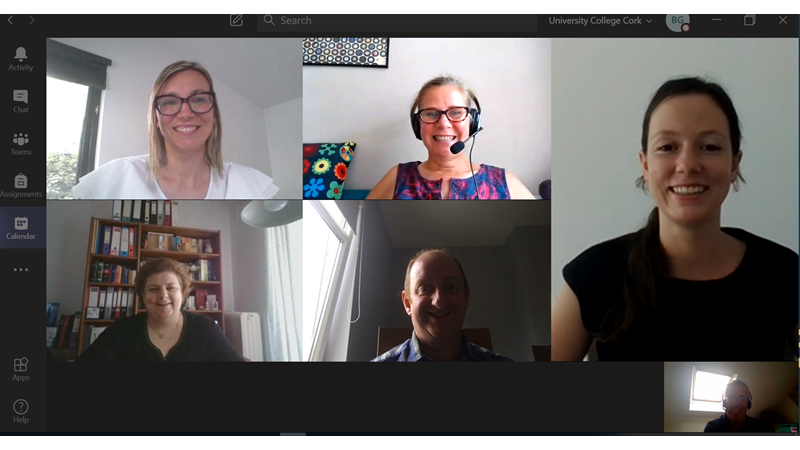| Laura Henze has recently successfully defended her PhD online on exploring the utility of the porcine model for predicting bio-enabling oral drug products performance in humans. We have taken this opportunity to ask her some questions in an interview on her research, her experience in PEARRL and her plans for the future. |
1. What has your research project focused on and what are your key results and innovations coming from your research project?
My research project focused on the suitability of the pig as a preclinical model in oral drug product development. We established in vitro- in silico models for the pig that improve interpretation of preclinical results which can streamline the drug development process.
2. What impact does your research project and your outcomes have?
The pig biorelevant medium developed as part of this work will be hugely beneficial to industry during the drug development process, streamlining early phases in preclinical development phases. Obtaining relevant information at an early stage of development facilitates a more efficient development process, which can save time and money for industry, as well as enabling earlier access of patients to new medicines. By incorporating species specific in vitro – in silico tools, a better understanding of the factors affecting the performance of the drug can be achieved. This should help to reduce the number of animals required in the future, highly beneficial from both a resource and ethical point of view.
3. What were your personal highlights over the course of your research project?
The training provided within the PEARRL project helped me to continue to develop and progress professionally by gaining new skills and knowledge. It was a great experience to work in an international network with experts in the field, with an added benefit of getting very constructive feedback to improve your research, and discuss the latest results of your research. In addition, it was a great opportunity to build collaborations between all the projects, work packages and partners involved in PEARRL. Several conferences and workshops gave us an opportunity to present and talk about our research.
4. Are there any elements of the training you received that you find should be integrated in local doctoral programmes?
I think the regulatory secondments were a great part of the PEARRL project. I really enjoyed my secondment at the HPRA in Dublin, it was great to experience the regulatory environment. Further training provided at the PEARRLs of wisdom weeks were hugely enjoyable.
5. How did the PEARRL network impact your doctoral experience?
Being part of the PEARRL network hugely benefited my doctoral experience, a key part was European wide network that combines academia, industry and regulatory authorities. Especially the chance of being in contact and getting feedback from experts around the globe improved my work enormously.
6. What are your plans for the future?
I have recently started a position as a Postdoc at Janssen Pharmaceutica in Beerse Belgium, as part of the Dissolution Sciences team.
My research project focused on the suitability of the pig as a preclinical model in oral drug product development. We established in vitro- in silico models for the pig that improve interpretation of preclinical results which can streamline the drug development process.
2. What impact does your research project and your outcomes have?
The pig biorelevant medium developed as part of this work will be hugely beneficial to industry during the drug development process, streamlining early phases in preclinical development phases. Obtaining relevant information at an early stage of development facilitates a more efficient development process, which can save time and money for industry, as well as enabling earlier access of patients to new medicines. By incorporating species specific in vitro – in silico tools, a better understanding of the factors affecting the performance of the drug can be achieved. This should help to reduce the number of animals required in the future, highly beneficial from both a resource and ethical point of view.
3. What were your personal highlights over the course of your research project?
The training provided within the PEARRL project helped me to continue to develop and progress professionally by gaining new skills and knowledge. It was a great experience to work in an international network with experts in the field, with an added benefit of getting very constructive feedback to improve your research, and discuss the latest results of your research. In addition, it was a great opportunity to build collaborations between all the projects, work packages and partners involved in PEARRL. Several conferences and workshops gave us an opportunity to present and talk about our research.
4. Are there any elements of the training you received that you find should be integrated in local doctoral programmes?
I think the regulatory secondments were a great part of the PEARRL project. I really enjoyed my secondment at the HPRA in Dublin, it was great to experience the regulatory environment. Further training provided at the PEARRLs of wisdom weeks were hugely enjoyable.
5. How did the PEARRL network impact your doctoral experience?
Being part of the PEARRL network hugely benefited my doctoral experience, a key part was European wide network that combines academia, industry and regulatory authorities. Especially the chance of being in contact and getting feedback from experts around the globe improved my work enormously.
6. What are your plans for the future?
I have recently started a position as a Postdoc at Janssen Pharmaceutica in Beerse Belgium, as part of the Dissolution Sciences team.


 RSS Feed
RSS Feed
